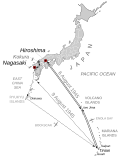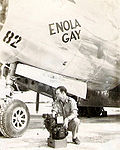Enola Gay
The Enola Gay is a B-29 Superfortress Bomber. This plane is famous for dropping the first atomic bomb (named Little Boy) over the Japanese city of Hiroshima during World War II. The Bomber is named after its Pilot, Paul Tibbets' mother Enola Gay Tibbets.[1][3] The plane was used from 18 May 1945 to 24 July 1946, after which it was stored at Suitland, Maryland.
Enola Gay Media
Enola Gay after the Hiroshima mission, entering hardstand. It is in its 6th Bombardment Group livery, with victor number 82 visible on fuselage just forward of the tail fin.
Little Boy unit on a trailer cradle in a bomb pit on Tinian, before loading into Enola Gay's bomb bay
At the time this photo was made, smoke billowed 20,000 feet above Hiroshima while smoke from the burst of the first atomic bomb had spread over 10,000 feet on the target at the base of the rising column. Six planes of the 509th Composite Group, participated in this mission; one to carry the bomb Enola Gay, one to take scientific measurements of the blast The Great Artiste, the third to tak
The mission runs of 6 and 9 August, with Hiroshima, Nagasaki, and Kokura (the original target for 9 August) displayed
Bombardier Thomas Ferebee with the Norden Bombsight on Tinian after the dropping of the Little Boy
Cockpit section of Enola Gay in the Smithsonian storage facility at Suitland, 1987
The Enola Gay on display at the National Air and Space Museum, Steven F. Udvar-Hazy Center
References
- ↑ 1.0 1.1 Grant, R. G. (2005). Hiroshima (How Did It Happen?). Franklin Watts. ISBN 9780749677220.
- ↑ "Col. Tibbets aboard the Enola Gay". Atomic Archive. Archived from the original on 2011-02-04. Retrieved 2011-03-01.
- ↑ "Paul Tibbets Commanded Enola Gay, dropped first atomic bomb on Hiroshima". Archived from the original on 2009-02-23. Retrieved 2009-06-19.










